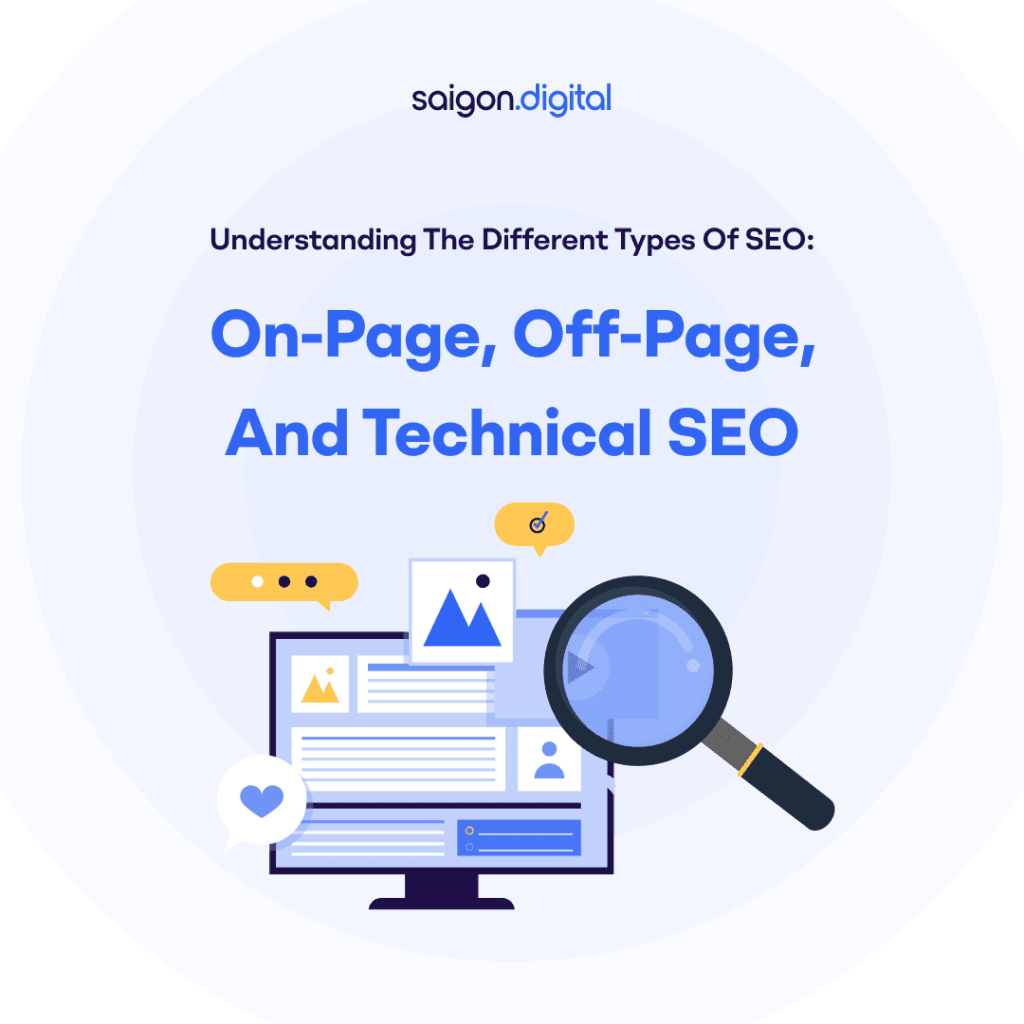
What Are Core Types of SEO?
- On-Page SEO: Also known as on-site SEO, this involves any actions you can take directly on your webpage to enhance its rankings. It is centred on aiding both Google and users in better comprehending and absorbing your content.
- Off-Page SEO: This refers to any activities performed outside your website with the aim of boosting its search engine rankings. While it's often associated with link building, it encompasses much more than that.
- Technical SEO: This aspect of SEO focuses on optimising your site so that search engines can easily find, crawl, interpret, and index your pages. The primary objective is to be discovered and improve your site's rankings.
1. On-Page SEO: Optimising Individual Pages
On-Page SEO refers to the practice of optimising individual web pages to rank higher and earn more relevant traffic in search engines. This type of SEO involves several elements that contribute to a page’s overall quality and relevance.Key Elements of On-Page SEO
- H1 Tag and Headings
- Importance: The H1 tag is the main heading of a page, crucial for SEO as it signals the primary topic of the content to search engines.
- Best Practices: Use only one H1 tag per page, ensure it is descriptive and includes the target keyword. Subheadings (H2, H3, etc.) should be used to structure the content and make it easier for both users and search engines to understand.
- Alt Text for Images
- Importance: Alt text describes the content of images on a page, helping search engines understand the context and aiding visually impaired users.
- Best Practices: Write concise, descriptive alt text for all images, including relevant keywords where appropriate.
- SEO Headlines
- Importance: Headlines play a critical role in capturing the user’s attention and improving click-through rates from search engine results pages (SERPs).
- Best Practices: Craft compelling and informative headlines that incorporate primary keywords without resorting to clickbait tactics.
- Internal Links and Anchor Text
- Importance: Internal links connect different pages of your website, aiding navigation and distributing page authority.
- Best Practices: Use descriptive anchor text that includes relevant keywords. Avoid overloading a page with too many internal links and ensure that each link serves a clear purpose.
- Meta Descriptions
- Importance: Meta descriptions provide a brief summary of a page’s content in SERPs, influencing click-through rates.
- Best Practices: Write clear, engaging meta descriptions (up to 160 characters) that include target keywords. Avoid duplicate meta descriptions across different pages.
2. Off-Page SEO: Building Authority and Trust
Another types of SEO is Off-Page SEO. This type involves activities conducted outside of your website to improve its ranking and authority. This primarily revolves around building high-quality backlinks, which signal to search engines that your site is trustworthy and relevant.
Key Strategies for Off-Page SEO
- Link Building
- Importance: Backlinks from reputable websites serve as votes of confidence, enhancing your site’s credibility and authority.
- Best Practices: Focus on acquiring backlinks from high-authority sites through guest blogging, influencer outreach, and creating shareable content. Use link building tools to identify opportunities and track progress.
- Social Media Engagement
- Importance: Active social media profiles can drive traffic to your website and increase your content’s visibility.
- Best Practices: Regularly share your content on social media platforms, engage with your audience, and encourage social sharing.
- Guest Blogging
- Importance: Writing guest posts for other reputable blogs can help you earn quality backlinks and reach a wider audience.
- Best Practices: Identify popular blogs in your industry, pitch relevant topics, and ensure your content is valuable and well-written.
- Monitoring Backlinks
- Importance: Keeping track of who links to your site helps maintain a healthy backlink profile and identify any potential issues.
- Best Practices: Use tools like Google Search Console and Ahrefs to monitor your backlinks and disavow any harmful links that could negatively impact your SEO.
3. Technical SEO: Enhancing Site Performance
Technical SEO is one of the core types of SEO. It focuses on optimising your website’s infrastructure to make it easier for search engines to crawl and index your content. This type of SEO is crucial for improving your site’s usability and performance.
Key Elements of Technical SEO
- Site Speed
- Importance: Page load speed is a critical ranking factor that directly impacts user experience and conversion rates.
- Best Practices: Optimise images, leverage browser caching, and use Content Delivery Networks (CDNs) to improve site speed.
- Mobile-Friendliness
- Importance: With the majority of searches now conducted on mobile devices, ensuring your site is mobile-friendly is essential.
- Best Practices: Use responsive design, optimise images and content for mobile devices, and ensure easy navigation on smaller screens.
- XML Sitemaps
- Importance: An XML sitemap helps search engines understand your site’s structure and find all relevant pages.
- Best Practices: Create and submit an XML sitemap to search engines like Google to ensure all important pages are indexed.
- Robots.txt
- Importance: The robots.txt file guides search engine crawlers on which pages to crawl and which to ignore.
- Best Practices: Use a robots.txt file to prevent search engines from indexing duplicate or low-value pages, optimising crawl budget.
- Structured Data
- Importance: Structured data helps search engines understand the content of your pages, which can enhance your visibility with rich snippets.
- Best Practices: Implement structured data using schema markup to provide additional information about your content to search engines.
4. Local SEO
Local SEO involves a range of tactics to improve a website's visibility and ranking in local search results. It targets specific geographic locations to boost a business’s presence on local search engines, directories, and maps.Local SEO helps businesses become more visible in local searches, attract local customers, and increase foot traffic to physical locations. Key strategies include optimising websites for local keywords, building citations and backlinks from local sources, managing online reviews, and improving Google My Business and other local listings.Key Elements of Local SEO
- Google My Business (GMB) Optimisation: Essential for improving your visibility in local search results and on Google Maps. Include important information like your address, contact number, opening hours, and photos.
- On-Page SEO: Focus on creating location-specific content, ensuring consistent NAP (Name, Address, Phone number) details, and using local keywords.
- Local Citations: Ensure accurate and consistent business listings on various sites, social media, and directories to build credibility.
- Online Reviews: Encourage and manage reviews on platforms like Google and Yelp, as positive feedback can strengthen your local SEO.
- Mobile Optimisation: Make sure your website is mobile-friendly, as many local searches are done on mobile devices.
- Backlinks: Gain quality backlinks from local websites and relevant publications to improve your local authority.
- Content Marketing & Social Media: Develop valuable local content and use social media to engage with the community and promote your services.
5. E-commerce SEO
E-commerce SEO is the process of optimising an online store to increase its visibility and ranking on search engine results pages (SERPs). By enhancing elements like product pages, category pages, and blog content, you can attract more organic traffic and boost sales. This type of SEO is crucial for digital marketing success.
Key Elements of E-Commerce SEO
E-commerce SEO is about optimising online shops to improve their search engine presence and draw in potential customers. Key components include:- Keyword Research: Finding and targeting the right keywords related to your products or services.
- Product Descriptions: Writing unique, engaging product descriptions with naturally integrated keywords.
- On-Page Optimisation: Improving product and category pages by refining meta titles, descriptions, headers, and image alt text.
- User-Friendly URLs: Creating clean, keyword-rich URLs that accurately reflect the page content.
- Site Structure: Ensuring a logical layout for easy navigation by users and search engines.
- Mobile Optimisation: Optimising the site for mobile devices to cater to the growing number of mobile shoppers.
6. Mobile SEO
Mobile SEO refers to the practice of optimising a website for search engines while also ensuring it displays correctly on mobile devices, such as smartphones and tablets.
A poor mobile experience with a brand can discourage customers from returning. To provide the best possible experience for your users, it's essential to implement mobile SEO. This involves ensuring that the design, layout, and loading speed of your website do not frustrate or drive away mobile visitors.
Key Elements of Mobile SEO
- Mobile-Friendly Design: Use responsive design to ensure the website adjusts seamlessly to different screen sizes and devices, offering a consistent and user-friendly experience on mobiles and tablets.
- Page Speed Optimisation: Mobile users expect fast-loading pages. Optimising images, leveraging browser caching, and minimising code (CSS, JavaScript) can significantly improve page load times.
- User Experience (UX): Ensure a clean, intuitive layout with easy navigation, readable text without zooming, and appropriately sized buttons and links for touch screens.
- Mobile-First Indexing: Google predominantly uses the mobile version of a website's content for indexing and ranking. Ensure that the mobile version contains all the necessary content that the desktop version has.
- Optimised Content: Content should be concise and readable on smaller screens. Use shorter paragraphs, bullet points, and headings to break up text and improve readability.
- Pop-up and Interstitial Management: Avoid intrusive pop-ups that can frustrate mobile users. Google penalises sites with intrusive interstitials that disrupt the user experience.
7. Image SEO
Image SEO refers to the optimisation of images and their hosting platforms to improve their ranking in search engine results and boost organic traffic.
Key Elements of Image SEO
Optimising images is crucial for increasing their visibility in search engine results and improving overall site SEO. Key aspects include:- File Names: Use descriptive, keyword-rich file names instead of generic ones like "image001.jpg."
- Alt Text: Provide clear, concise alt text for each image. This helps search engines understand the content and improves accessibility.
- Image Size and Compression: Optimise image sizes to improve site speed without losing quality. Compress files to reduce size while maintaining clarity.
- Image Format: Choose the right format—JPEG for photos, PNG for transparency, and WebP for a balance of compression and quality.
- Responsive Images: Ensure images are responsive and adjust to various screen sizes. This supports mobile-friendliness and is considered by search engines.
- Image Sitemap: Include images in your XML sitemap to help search engines index them and understand their context within your site.
8. Video SEO
Video SEO is the process of optimising video content and hosting platforms to improve their rankings in search engine results and attract more organic traffic. The aim is to boost a video’s visibility, increase views, and drive website traffic.
Key Elements of Video SEO
Video SEO enhances video discoverability and rankings on search engines, helping reach a wider audience. Key components include:- Keyword Research: Identifying relevant keywords for your video using tools to find terms with good search volume related to your topic.
- Video Title: Crafting a keyword-rich title that accurately reflects the content and encourages clicks.
- Video Description: Writing a detailed description that explains the content, naturally integrating keywords, and adding links to related resources.
- Tags: Using relevant tags to help search engines understand the video’s context and improve its discoverability.
- Thumbnail Optimisation: Creating an eye-catching thumbnail to grab viewers' attention and drive clicks.
- Transcriptions and Captions: Providing transcriptions or captions to improve accessibility and help search engines understand the content.
9. Voice Search SEO
Voice Search SEO is one of the newest types of SEO. It's an emerging type of optimisation that focuses on enhancing search visibility through voice-activated devices like Alexa, Google Home, and Siri. As voice search becomes increasingly popular, it is crucial to adapt your SEO strategy to accommodate this trend.
Optimising for voice search involves targeting keywords that people use in spoken language, including colloquial terms and slang.
Key Elements of Voice Search SEO
- Natural Language Keywords: Use keywords that reflect natural, conversational speech, as voice searches are often more informal and question-based.
- Featured Snippets: Strive to appear in featured snippets, as many voice search responses are sourced from these concise, informative answers.
- Local Optimisation: Tailor content for local searches since many voice queries are location-specific. Ensure your business details, like address and phone number, are accurate and up-to-date.
- Conversational Content: Develop content that mirrors everyday speech. Write in a conversational tone and provide straightforward answers to common queries.
- User Intent Understanding: Grasp the intent behind voice searches. Optimise for various types of queries—informational, navigational, and transactional—to better meet user needs.





